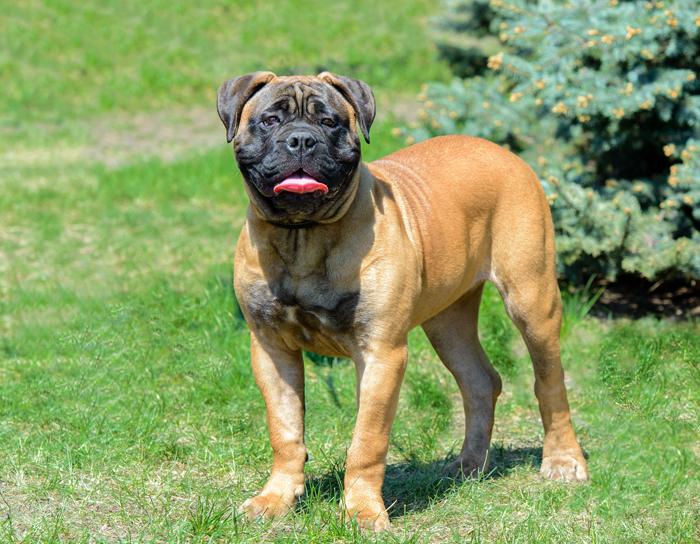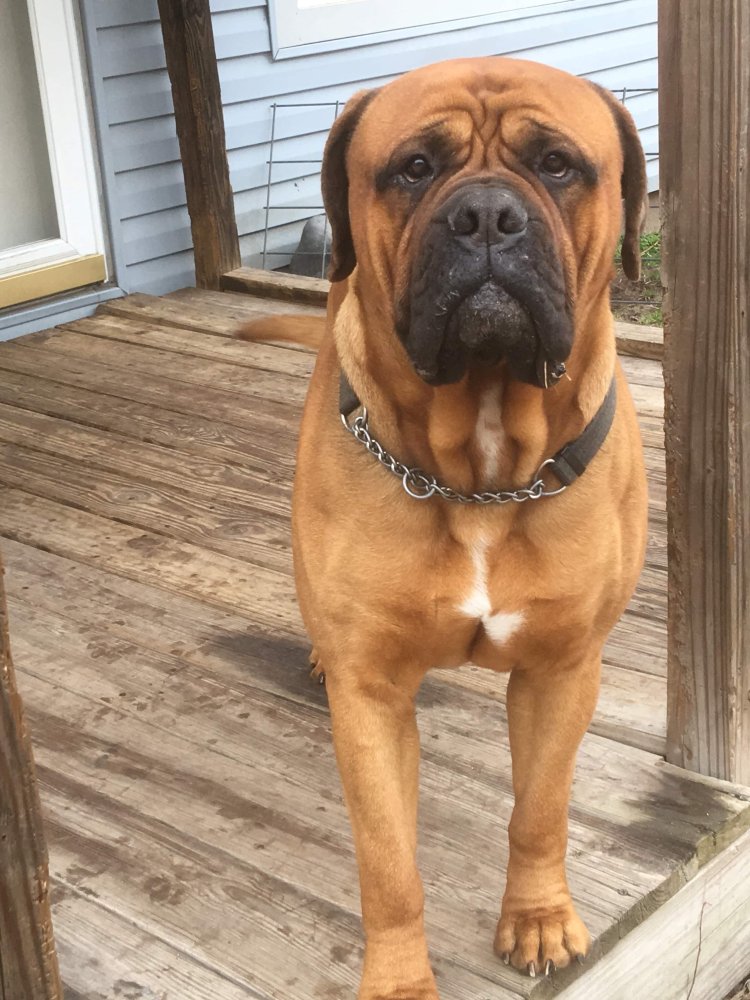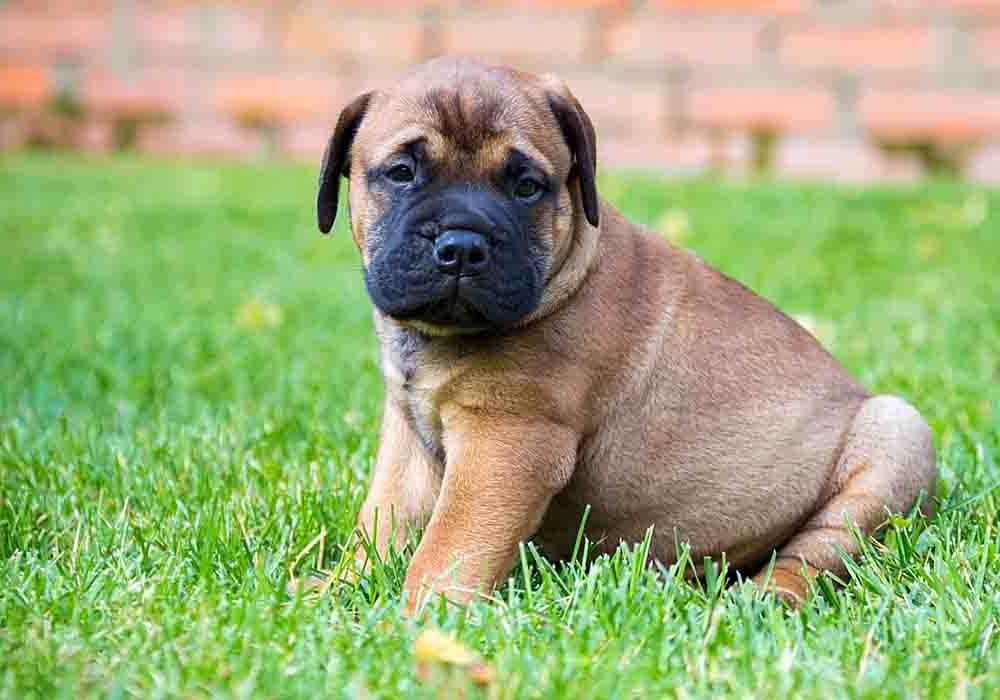- Breed Category: Working Group
- Country of Origin: United Kingdom
- Average Height: Males 64-69 cm, Females 61-66 cm
- Average Weight: Males 50-59 kg, Females 45-54 kg
- Average Life Span: 7 to 9 years
- Grooming Requirements: Low, occasional brushing
- Exercise Requirements: Moderate, daily walks
- Coat Type: Short and dense
- Coat Color Variations: Fawn, red, brindle
- Shedding Level: Moderate
- Ear Type: V-shaped, folded
- Tail Type: Straight, set high
- Temperament: Loyal, protective, calm
- Intelligence Level: High
- Barking Tendency: Low
- Compatibility with Children: Very good
- Compatibility with Other Pets: Good with proper socialisation
- Training Ease: Moderate, firm handling needed
- Common Health Issues: Hip dysplasia, bloat, cancer
- Dietary Needs: High-quality, balanced diet
- Energy Level: Moderate
- Drooling Tendency: High
- Sensitivity to Weather: Sensitive to heat
- Overall Maintenance Level: Moderate
- Original Purpose: Guarding estates
- Year of Recognition by Kennel Clubs: 1924
- Apartment Friendly: Yes, with sufficient exercise
- Best Suited For: Families, experienced dog owners
- Cost of Ownership: Moderate to high
- Unique Traits: Silent watchdog, powerful build
- Popularity Rank: Popular in working breeds
Imagine a dog that combines strength, loyalty, and a gentle nature. That’s the Bull Mastiff for you. Known for their imposing size and protective instincts, these dogs are a fascinating blend of power and affection. Originally bred in England during the 19th century, Bull Mastiffs were designed to guard estates against poachers. Their history is rich, and their role as guardians is still evident today. This article aims to delve into the unique characteristics of the Bull Mastiff, exploring their history and offering insights into their care. Whether you’re considering adding one to your family or simply curious, understanding this breed’s needs and traits is essential for a harmonious relationship.
History and Origin of the Bull Mastiff

Early Development of the Breed
The Bull Mastiff’s story begins in the 19th century in England. Gamekeepers needed a dog that could protect estates from poachers, and the Bull Mastiff was the answer. By crossing the English Mastiff with the Bulldog, breeders created a dog that was both powerful and agile. This combination resulted in a breed that could quietly track intruders and, if necessary, pin them down without causing harm.
Role in Guarding Estates and Properties
These dogs were more than just pets; they were essential partners in estate management. Their keen senses and imposing presence made them perfect for the job. They were trained to work silently, using their strength and intelligence to outsmart poachers. Even today, their guarding instincts remain strong, making them excellent protectors of homes and families.
Key Historical Figures Involved in the Breed’s Creation
One notable figure in the Bull Mastiff’s development was the gamekeeper of the Duke of Beaufort. His efforts in refining the breed’s characteristics were instrumental. By selecting dogs with the right temperament and physical traits, he helped shape the Bull Mastiff into the reliable guardian we know today.
Physical Characteristics of the Bull Mastiff

Appearance
The Bull Mastiff is a large and impressive dog, often weighing between 50 to 60 kilograms. Their size alone is enough to make anyone take notice. They have a short, dense coat that comes in a variety of colours, including fawn, red, and brindle. These colours often feature a distinctive black mask around the face, adding to their striking appearance. Their eyes are dark and expressive, giving them a thoughtful look.
Unique Physical Traits
One of the most notable features of the Bull Mastiff is their strong, muscular build. This breed is all about power and agility, a combination that served them well in their original role as estate guardians. Their broad chest and sturdy legs give them a solid stance, while their large head and strong jaw are unmistakable. Despite their size, they move with surprising grace, a testament to their well-balanced physique.
Temperament and Behaviour of the Bull Mastiff

Typical Personality Traits
Bull Mastiffs are known for their loyalty and intelligence. These dogs are incredibly devoted to their families, often forming strong bonds with their human companions. Their protective nature is one of their standout traits, making them excellent watchdogs. Despite their imposing appearance, they are gentle giants at heart, often displaying a calm and affectionate demeanour.
Suitability as a Family Pet and Guard Dog
As family pets, Bull Mastiffs are a great choice for those who appreciate a dog that can offer both companionship and security. Their natural guarding instincts mean they are always alert to potential threats, yet they are not overly aggressive. This balance makes them suitable for families looking for a pet that can also serve as a protector.
Interaction with Children and Other Animals
When it comes to children, Bull Mastiffs are generally patient and tolerant. They tend to be gentle with kids, making them a good fit for families with young ones. However, due to their size, supervision is recommended during playtime. With other animals, early socialisation is key. Properly introduced, they can coexist peacefully with other pets, although their protective instincts may sometimes come into play.
Training and Exercise Needs of the Bull Mastiff

Importance of Early Training and Socialisation
Getting a Bull Mastiff off to a good start with early training and socialisation is crucial. These dogs are naturally protective, so introducing them to different people, environments, and other animals early on helps them grow into well-rounded adults. This early exposure can prevent unwanted behaviours and ensure they are comfortable in various situations.
Recommended Training Techniques
When it comes to training, consistency and positive reinforcement are key. Bull Mastiffs respond well to praise and treats, so rewarding good behaviour is effective. Keep training sessions short and engaging to hold their attention. Patience is important, as these dogs can be a bit stubborn at times, but with the right approach, they learn quickly.
Daily Exercise Requirements and Activities They Enjoy
Despite their size, Bull Mastiffs don’t require excessive exercise. A couple of daily walks and some playtime in the yard usually suffice. They enjoy activities that engage their minds, like puzzle toys or obedience games. While they love a good romp, they also appreciate downtime, making them adaptable to different lifestyles.
Health and Lifespan of the Bull Mastiff

Common Health Issues
Bull Mastiffs, like many large breeds, can face specific health challenges. Hip and elbow dysplasia are common, often leading to arthritis as they age. Bloat, a serious condition affecting the stomach, is another concern. Regular vet check-ups can help catch these issues early.
Average Lifespan and Health Tips
On average, Bull Mastiffs live between 7 to 10 years. To keep them healthy, a balanced diet and regular exercise are essential. While they don’t need intense workouts, daily walks and mental stimulation are important. Keeping their weight in check can also prevent joint problems.
Preventative Care Recommendations
Preventative care is key to a Bull Mastiff’s well-being. Regular vet visits for vaccinations and health screenings are crucial. Dental care shouldn’t be overlooked; brushing their teeth can prevent gum disease. Additionally, maintaining a flea and tick prevention routine will keep them comfortable and healthy.
Grooming and Maintenance of the Bull Mastiff

Coat Care and Grooming Routines
The Bull Mastiff’s short, dense coat is relatively low-maintenance, but regular grooming is still important. A weekly brush with a rubber grooming mitt or a bristle brush helps remove loose hair and keeps their coat looking its best. This routine not only maintains their appearance but also strengthens the bond between you and your dog.
Shedding and Seasonal Grooming Tips
While Bull Mastiffs are not heavy shedders, they do experience seasonal shedding, typically in spring and autumn. During these times, more frequent brushing can help manage the extra hair. A bath every few months, or as needed, will keep their coat clean and healthy. Always use a dog-specific shampoo to avoid skin irritation.
Regular grooming also provides an opportunity to check for any skin issues or parasites. Pay attention to their ears, eyes, and nails, ensuring they are clean and trimmed. This comprehensive approach to grooming will keep your Bull Mastiff comfortable and looking great all year round.
Diet and Nutrition for Bull Mastiffs

Nutritional Needs for Optimal Health
Feeding a Bull Mastiff isn’t just about filling a bowl. It’s about providing the right nutrients to support their large frame and active lifestyle. A balanced diet rich in high-quality proteins, healthy fats, and essential vitamins is crucial. Proteins help maintain muscle mass, while fats provide energy. Don’t forget about calcium and phosphorus for strong bones.
Foods to Include and Avoid
Include lean meats like chicken or beef, along with fish for omega-3 fatty acids. Vegetables such as carrots and spinach offer vitamins and fibre. Avoid foods high in fillers, artificial additives, and excessive grains. Chocolate, onions, and grapes are definite no-gos, as they can be toxic to dogs.
Feeding Schedules and Portion Recommendations
Consistency is key. Feed your Bull Mastiff twice a day to prevent bloat, a common issue in large breeds. Portion sizes depend on their age, weight, and activity level, so consult your vet for tailored advice. Remember, overfeeding can lead to obesity, so keep an eye on their weight and adjust portions as needed.
Fun Facts and Trivia about Bull Mastiffs

Interesting Tidbits about the Breed
Bull Mastiffs are often called the “Silent Watchdogs” because of their unique approach to guarding. Unlike other breeds that bark to alert, Bull Mastiffs prefer to quietly observe and act only when necessary. This makes them excellent for those who prefer a quieter home environment.
Did you know that Bull Mastiffs have a natural instinct to pin intruders rather than attack? This trait was specifically bred into them to help gamekeepers capture poachers without causing harm.
Famous Bull Mastiffs in Media or History
In the world of cinema, Bull Mastiffs have made their mark too. One of the most famous Bull Mastiffs is “Butkus,” the beloved pet of Sylvester Stallone, who appeared in the original “Rocky” film. Stallone’s real-life bond with Butkus added an authentic touch to the movie.
Historically, Bull Mastiffs have been associated with nobility. They were often found in the estates of English aristocrats, serving as both companions and protectors, a testament to their versatility and reliability.
Final Thoughts

The Bull Mastiff is a powerful yet gentle guardian. Their unique blend of strength and loyalty makes them exceptional companions. While they require thoughtful training and care, the rewards of their companionship are immense. Understanding their needs and history enriches the bond between owner and pet, ensuring a harmonious relationship. Consider welcoming a Bull Mastiff into your life for a loyal and protective friend.
